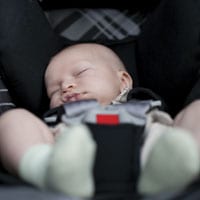Is it safe for your baby to face backwards?
For years, parents and infants alike have looked forward to that major milestone—when baby could safely ride forward-facing in her car seat—usually around her first birthday if she had reached at least 20 pounds.
Now, new recommendations from the American Academy of Pediatrics are advising parents to keep their infants and toddlers facing backwards until age 2, or until they reach the maximum height and weight for their seat.
Read: Safest Car Seats For Baby
Keep baby safe in cars
“Parents often look forward to transitioning from one stage to the next, but these transitions should generally be delayed until they’re necessary, when the child fully outgrows the limits for his or her current stage,” said Dennis Durbin, MD, FAAP, lead author of the AAP policy.
“A rear-facing child safety seat does a better job of supporting the head, neck and spine of infants and toddlers in a crash, because it distributes the force of the collision over the entire body,” Dr. Durbin said. “For larger children, a forward-facing seat with a harness is safer than a booster, and a belt-positioning booster seat provides better protection than a seat belt alone until the seat belt fits correctly.”
Rear-facing car seats safer
Car crashes are still the leading cause of death for children, even though the number of crashes have declined in recent years. New research has found that toddlers and children are safer in rear-facing car seats, and in fact, are up to 75% less likely to die or be severely injured in a crash if they are riding rear-facing.
“The ‘age 2’ recommendation is not a deadline, but rather a guideline to help parents decide when to make the transition,” Dr. Durbin said. “Smaller children will benefit from remaining rear-facing longer, while other children may reach the maximum height or weight before 2 years of age.”
Once your baby outgrows her infant car seat, or is age 2 or older, she should transition from a rear-facing seat to a forward-facing seat with a harness, until she reaches the maximum weight or height for that seat.
At that point, your child will be old enough to move to a booster seat that will position your car’s lap and shoulder belts for the proper, safe fit, the AAP says. In fact, the shoulder belt should lie across the middle of her chest and shoulder, not near her neck or face. The lap belt should fit low and snug on her hips and upper thighs, not across her belly. Most kids will need a booster seat until they have reached 4 feet 9 inches tall and are between 8 and 12 years old.
As for riding in that coveted front passenger seat, “children should ride in the rear of a vehicle until they are 13 years old,” says the AAP.
Also Read: Buckle Up: Car Seat Safety
Car Seat Recommendations
Infants ride rear-facing until age 2, or until they outgrow their car seat’s limits for weight and height.
Toddlers need to ride in a 5-point harness system until they can transition to a booster seat.
Children need to ride in a belt-positioning booster seat until they’re at least 4 feet 9 inches tall, and are at least 8 years old.
Source: American Academy of Pediatrics
Related article: Infant Car Seats a Laceration Hazard






Comments are closed.